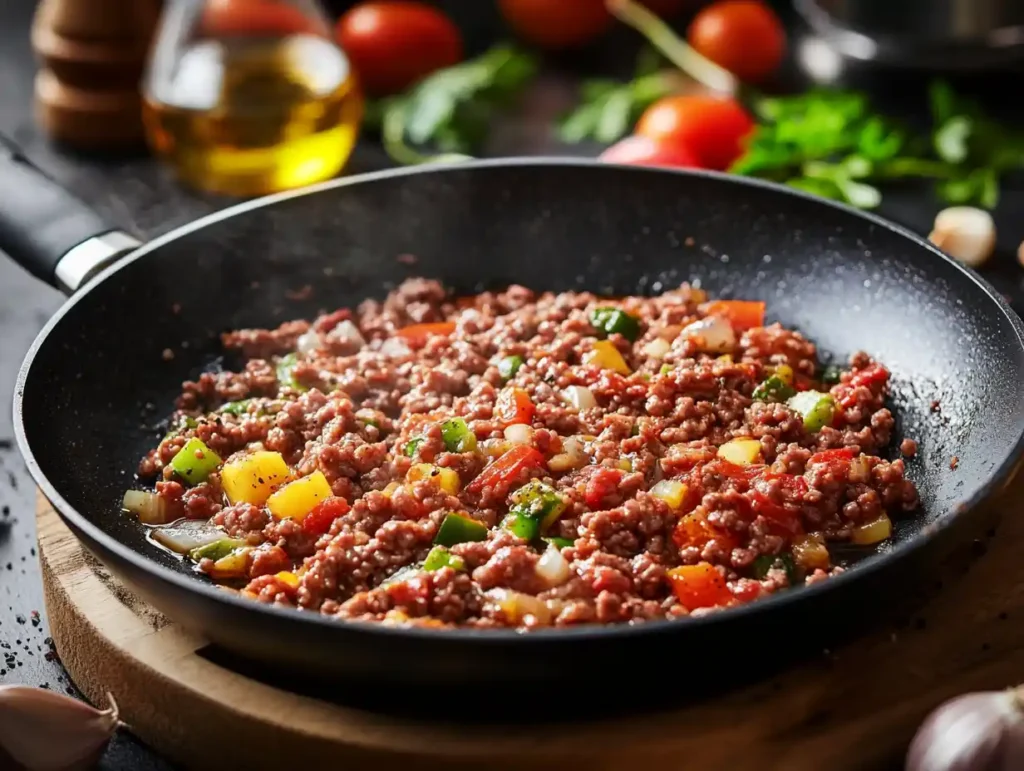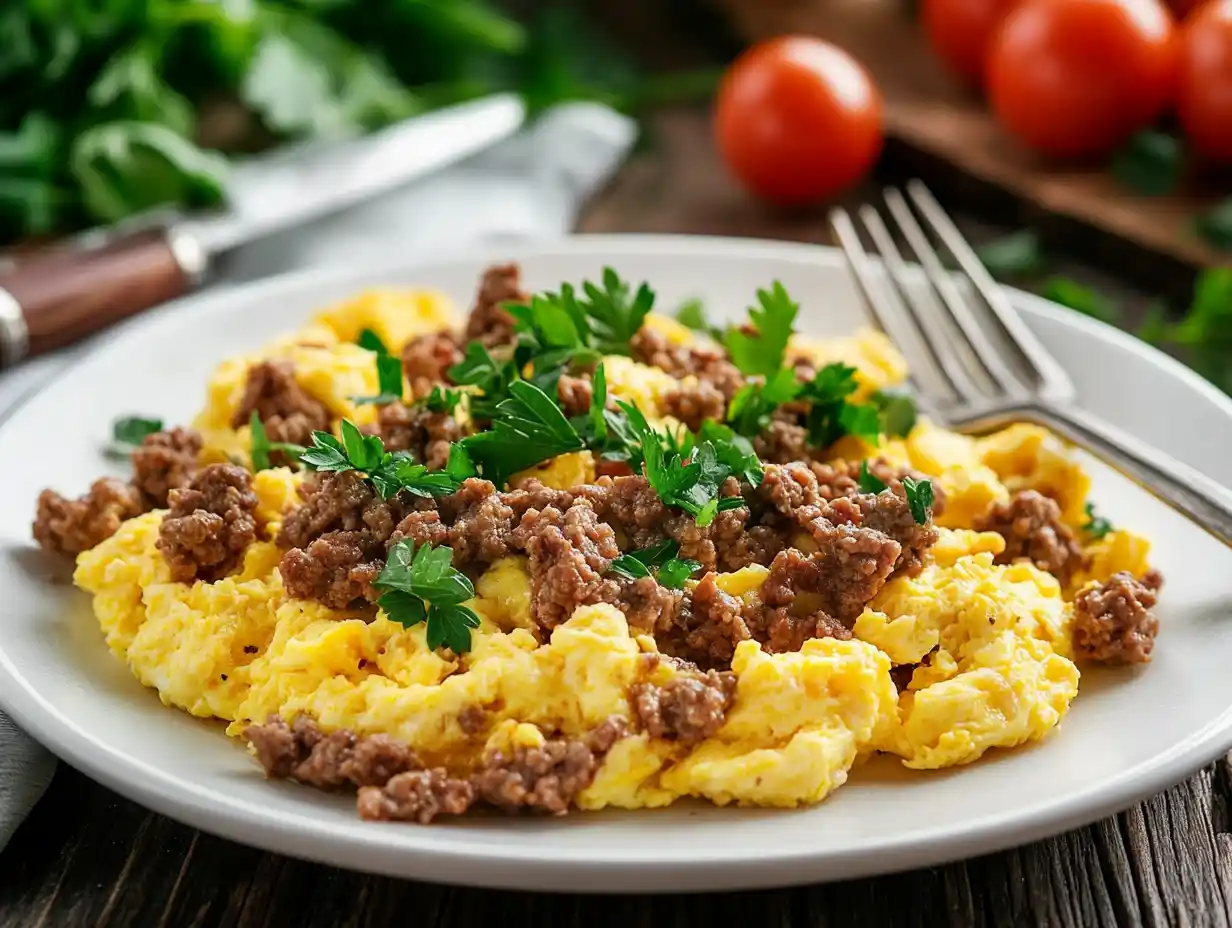When it comes to quick, protein-packed meals, ground beef and scrambled eggs are two popular choices. But have you ever wondered exactly how many calories are in ground beef and scrambled eggs? Whether you’re meal prepping, counting calories, or planning a high-protein diet, knowing the nutritional breakdown of these foods can make all the difference.
Ground beef and scrambled eggs are versatile ingredients that can be part of a hearty breakfast, a balanced lunch, or even a post-workout snack. However, their calorie content can vary based on portion size, cooking methods, and added ingredients like oil, butter, or cheese.
In this article, we’ll take a detailed look at the calorie content of both ground beef and scrambled eggs. From different fat percentages of beef to variations in egg preparation, we’ll uncover how these foods can fit into your diet without derailing your nutrition goals.
Let’s dive in and explore the calories, health benefits, and cooking tips for ground beef and scrambled eggs to help you make informed choices!
Table of Contents
Nutritional Overview of Ground Beef and Scrambled Eggs
Ground Beef Nutritional Profile
Ground beef is one of the most versatile and commonly used protein sources. Its nutritional profile can vary depending on the fat content. Typically, ground beef is available in the following varieties based on fat-to-lean ratios:
- 70% Lean / 30% Fat – Higher fat content, often used for burgers.
- 80% Lean / 20% Fat – Balanced fat content, popular for tacos and meatloaf.
- 90% Lean / 10% Fat – Lower fat, often preferred for healthier options.
- 95% Lean / 5% Fat – Very lean, great for calorie-conscious diets.
Calorie Content in Different Fat Percentages of Ground Beef
| Fat Percentage | Calories per 100g (Raw) | Calories per 100g (Cooked) |
|---|---|---|
| 70% Lean | 250 | 310 |
| 80% Lean | 230 | 275 |
| 90% Lean | 176 | 210 |
| 95% Lean | 136 | 155 |
Scrambled Eggs Nutritional Profile
Scrambled eggs are another popular source of protein and essential nutrients like vitamin D, B12, and choline. They’re quick to cook and easy to modify with additional ingredients.
Calorie Breakdown Based on Cooking Methods
| Preparation Method | Calories per Serving (2 Eggs) |
|---|---|
| Scrambled with no oil (plain) | 140 |
| Scrambled with butter (1 tsp) | 180 |
| Scrambled with cheese (1 oz) | 210 |
| Scrambled with milk (2 tbsp) | 160 |
Calories in Ground Beef – A Detailed Breakdown
Lean vs. Regular Ground Beef Calories
The calorie content in ground beef varies widely depending on its fat-to-lean ratio. The higher the fat percentage, the higher the calorie count, especially after cooking when some fat renders out but is still absorbed into the dish.
- 70% Lean (30% Fat) – This type is rich in fat and flavor, containing 250 calories per 100 grams raw and approximately 310 calories when cooked due to fat shrinkage. It’s ideal for burgers but might not be the best choice for calorie-conscious meals.
- 80% Lean (20% Fat) – A balanced option, providing about 230 calories per 100 grams raw and 275 calories when cooked. It’s commonly used for tacos, casseroles, and meatballs.
- 90% Lean (10% Fat) – Leaner than the others, this variety has 176 calories per 100 grams raw and 210 calories cooked. It’s great for meal prepping and health-focused diets.
- 95% Lean (5% Fat) – The leanest option, perfect for those watching calories, offering 136 calories raw and about 155 calories when cooked.
Cooking Impact on Caloric Value
Cooking ground beef reduces its water content while retaining much of its fat, leading to denser calorie content in the cooked version. For example:
- Raw 100g of 80% Lean Beef = 230 calories
- Cooked 100g of 80% Lean Beef = 275 calories
Additionally, the cooking method plays a role:
- Grilling – Allows excess fat to drain off, slightly lowering calories.
- Pan-frying – Retains more fat, slightly increasing calories.
- Boiling or poaching – Further reduces fat content and calories but alters flavor.
Portion Sizes and Their Caloric Impact
Let’s break down typical serving sizes:
- 1 oz (28g) cooked ground beef (80% lean) – About 77 calories.
- 3 oz (85g) cooked ground beef – About 232 calories.
- 4 oz (113g) cooked ground beef – Roughly 310 calories.
Larger servings can quickly add calories, especially if prepared with oil, butter, or sauces.
Calories in Scrambled Eggs – A Comprehensive Analysis
Nutritional Value of Eggs Before Cooking
A large egg (about 50 grams) contains approximately:
- 70 calories
- 6 grams of protein
- 5 grams of fat
- 1.6 grams of saturated fat
When cooked, the calorie count may rise depending on ingredients added during preparation.
Cooking Techniques and Their Effect on Calories
- Plain Scrambled Eggs – Using just eggs and a non-stick pan without oil or butter yields 140 calories for 2 large eggs.
- With Butter or Oil – Adding 1 teaspoon of butter or oil raises the calorie count to approximately 180 calories for 2 eggs.
- With Milk or Cream – Mixing 2 tablespoons of milk adds about 20 calories, making the total 160 calories.
- With Cheese – Adding 1 ounce of cheese increases the count significantly to 210 calories.
Additives and Ingredients That Increase Caloric Count
Eggs are often cooked with high-calorie ingredients, which can quickly change the nutritional profile. Common additions include:
- Cheese (100 calories per ounce)
- Heavy cream (50 calories per tablespoon)
- Sausages or bacon (80–150 calories per serving)
- Vegetables (low-calorie, under 20 calories per serving)
While these ingredients can enhance flavor, they also contribute to a higher calorie count, making portion control and ingredient selection critical for balanced meals.
Combined Calories in Ground Beef and Scrambled Eggs
Calorie Count of Popular Recipes Combining Both
- Beef and Egg Scramble (1 cup cooked ground beef + 2 scrambled eggs):
- Ground Beef (80% lean, 150g cooked) – 375 calories
- Scrambled Eggs (plain, 2 large) – 140 calories
- Total – 515 calories
- Omelet with Ground Beef (100g beef + 3 eggs):
- Ground Beef (90g cooked) – 210 calories
- Eggs (3 large) – 210 calories
- Butter (1 tsp) – 40 calories
- Total – 460 calories
Meal Planning for Weight Management
- Low-Calorie Option – Use 95% lean beef and cook eggs with non-stick spray instead of butter. Total calories: 295 per serving.
- High-Protein Option – Increase beef to 150g and add an extra egg for more protein without excessive fat. Total calories: 480 per serving.
- Keto-Friendly Option – Add cheese and cream for flavor, keeping carbs low while focusing on fats and proteins. Total calories: 600–700 per serving.
Health Benefits of Ground Beef and Scrambled Eggs
Protein Content and Muscle Building
Both ground beef and scrambled eggs are protein powerhouses, making them ideal for muscle building, recovery, and maintenance.
- Ground Beef – Packed with 25–27 grams of protein per 100 grams, depending on fat content, it supplies complete protein containing all nine essential amino acids necessary for muscle repair and growth.
- Scrambled Eggs – Each large egg provides about 6 grams of protein, contributing to muscle strength and satiety.
Protein-rich meals also boost metabolism through the thermic effect of food (TEF), helping burn more calories during digestion.
Essential Vitamins and Minerals in These Foods
Both foods are nutrient-dense, offering a wide range of vitamins and minerals:
- Ground Beef
- Iron – Supports oxygen transport in the blood and prevents anemia.
- Zinc – Enhances immune function and wound healing.
- B Vitamins (B12, B6, niacin) – Improve energy production and brain health.
- Scrambled Eggs
- Vitamin D – Promotes bone health by aiding calcium absorption.
- Choline – Essential for brain function and nerve signaling.
- Selenium – Acts as a powerful antioxidant, supporting immunity.
Together, these foods provide a balanced nutrient profile for energy, endurance, and overall wellness.
Balanced Nutritional Value for Active Lifestyles
For those following high-protein diets like keto, paleo, or bodybuilding plans, ground beef and scrambled eggs deliver:
- Low carb content – Ideal for maintaining ketosis or managing blood sugar levels.
- Healthy fats – Provide sustained energy and improve nutrient absorption.
- Versatility – Easy to prepare for breakfast, lunch, dinner, or post-workout recovery.
Cooking Tips to Minimize Calories

Healthy Cooking Oils and Alternatives
Switching to lower-calorie cooking methods helps reduce unnecessary fat and calories:
- Use non-stick pans – Skip butter or oil and prevent sticking with sprays like olive oil mist.
- Grill or broil beef – Allows excess fat to drip away instead of being absorbed.
- Boil or poach eggs – Avoids added fats compared to frying or scrambling with butter.
Avoiding High-Calorie Additions
- Cheese and Cream – Limit these ingredients or switch to low-fat versions to lower calories.
- Sauces and Condiments – Use salsa or hot sauce instead of high-calorie options like mayonnaise.
- Vegetables for Volume – Add spinach, mushrooms, or tomatoes to increase fiber and nutrients without adding many calories.
Portion Control and Serving Sizes
- Stick to 4–6 oz of cooked ground beef and 2–3 eggs per serving to balance calories and protein.
- Pre-measure ingredients instead of estimating to stay on track with calorie goals.
Meal Ideas and Serving Suggestions

Low-Calorie Breakfast Options
- Ground Beef and Egg Scramble – Use 95% lean beef (150g) with 2 eggs and spinach for a 300-calorie meal.
- Egg Muffins with Beef – Combine ground beef, egg whites, and vegetables in muffin tins for meal prep.
High-Protein Lunch and Dinner Ideas
- Beef and Egg Burrito Bowl – Layer lean ground beef, scrambled eggs, and avocado over cauliflower rice for a protein-packed, low-carb meal.
- Stuffed Bell Peppers – Fill peppers with ground beef, egg, and cheese for a balanced entrée.
Balanced Snack Options Using Both Ingredients
- Beef and Egg Wraps – Use lettuce wraps or low-carb tortillas to make portable, high-protein snacks.
- Mini Egg and Beef Patties – Form small patties with beef and eggs for quick snacks or appetizers.
Common Myths About Calories in Ground Beef and Eggs
Debunking Misconceptions About Fat and Cholesterol
- “Eggs Raise Cholesterol.”
- Studies show that dietary cholesterol from eggs has minimal impact on blood cholesterol in most people. Instead, eggs improve HDL (good cholesterol) levels.
- “Ground Beef Is Always High in Fat.”
- Lean beef options (90% or higher) provide high protein with low fat, making them suitable for heart-healthy diets.
- “You Can’t Eat These Foods for Weight Loss.”
- Protein-rich foods like beef and eggs increase satiety and support fat loss when consumed in moderation.
Separating Facts from Fiction in Calorie Counting
- Draining Fat Lowers Calories. Cooking and draining beef reduces fat and calories, making it a healthier option.
- Whole Eggs Are Nutrient-Dense. Unlike egg whites alone, whole eggs provide a complete nutritional package that promotes satiety.
FAQs: How Many Calories Are in Ground Beef and Scrambled Eggs?
What is the calorie count in 100 grams of ground beef?
The calorie count in 100 grams of ground beef largely depends on the fat percentage. For instance:
- 70% Lean Beef – Approximately 250 calories raw and 310 calories cooked.
- 80% Lean Beef – About 230 calories raw and 275 calories cooked.
- 90% Lean Beef – Roughly 176 calories raw and 210 calories cooked.
- 95% Lean Beef – Close to 136 calories raw and 155 calories cooked.
If you’re watching calories, opting for leaner varieties is a smarter choice.
How many calories are in 2 scrambled eggs?
Two scrambled eggs typically contain 140 calories when cooked plain without any added fat. However, the calorie count can rise based on preparation methods:
- With butter (1 tsp) – Around 180 calories.
- With cheese (1 oz) – Roughly 210 calories.
- With milk (2 tbsp) – About 160 calories.
Therefore, paying attention to the ingredients you add can make a big difference.
Are scrambled eggs high in fat?
Scrambled eggs naturally contain healthy fats since each egg has approximately 5 grams of fat, including 1.6 grams of saturated fat. Although the fat content increases with butter, cream, or cheese, eggs also provide omega-3 fatty acids that support heart health.
Thus, when prepared with minimal added fat, scrambled eggs can fit easily into a balanced diet.
Does draining fat from ground beef reduce calories?
Yes, draining and rinsing cooked ground beef can significantly reduce calories by removing excess fat. In fact, studies suggest that draining can eliminate up to 45% of fat content, depending on the cut.
For example:
- 80% Lean Beef (275 calories cooked) can drop to about 200 calories after draining and rinsing.
So, if you’re counting calories, this step is highly effective without sacrificing flavor.
What are the lowest-calorie cooking methods for these foods?
The healthiest cooking methods include:
- Ground Beef – Grilling, broiling, or boiling to allow fat to drip away.
- Scrambled Eggs – Using non-stick pans with cooking sprays instead of butter or oil.
These techniques help maintain flavor while keeping calories in check.
Can ground beef and scrambled eggs fit into a keto diet?
Absolutely! Both ground beef and scrambled eggs are keto-friendly due to their low carbohydrate content and high fat-to-protein ratio. They provide essential nutrients and energy without spiking blood sugar levels.
For example:
- Beef and Egg Scramble (with cheese and avocado) – Delivers healthy fats and protein for sustained energy.
- Egg-Stuffed Beef Patties – Combines flavors without adding carbs, making them ideal for keto meal plans.
Conclusion
In summary, ground beef and scrambled eggs are not only delicious and versatile, but they’re also packed with protein, essential vitamins, and minerals. While calorie content varies based on fat percentage, portion size, and cooking methods, both ingredients can easily fit into weight-loss, muscle-building, and keto diets when prepared thoughtfully.
By choosing leaner cuts of ground beef and low-fat egg preparations, you can enjoy these foods without exceeding your calorie goals. Additionally, combining them in balanced meals can help support energy levels, muscle growth, and overall nutrition.
Whether you’re crafting a protein-rich breakfast or a hearty dinner, ground beef and scrambled eggs are excellent choices. So, experiment with different recipes, seasonings, and cooking methods to create meals that suit your dietary needs and preferences.
For more insights into cooking with eggs and beef, check out when to add meat to scrambled eggs for timing tips. Explore are eggs and ground beef good together to learn about nutrition and flavor combinations. Don’t miss our guide on can you add eggs to ground beef for creative recipe ideas.

